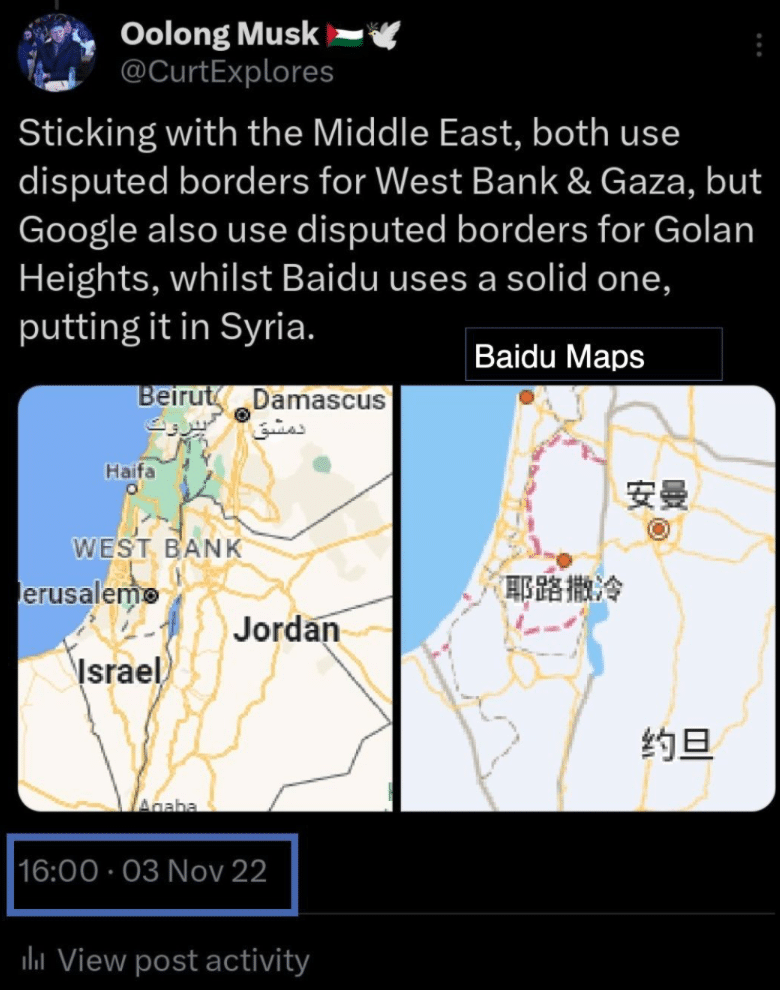Part III: Smashing Walls, Building Firewalls, and Breaking the Digital Siege
In the last section we explored the Axis of Resistance and its pursuit of material self-sufficiency, as well as Basel al-Araj’s incisive Mao-inspired analysis of asymmetric warfare against a technologically superior enemy. Building on that foundation, we now turn to two intentionally under- or misreported facets of the current conjuncture:
- The sovereign technological innovations developed by the Palestinian resistance under siege conditions in Gaza, particularly in the fields of weaponry, counterintelligence and counter-surveillance, and information warfare; and
- How these are enabled, reinforced, and amplified by China’s own project of sovereign technological development and delinking from Western digital monopolies—a target of renewed opprobrium since the start of the war.
Both phenomena are manifestations, under vastly different circumstances, of what Max Ajl describes in the context of the Resistance Axis as “the dialectical relationship between technological upgrading, defensive industrialization, and armed defensive capacity to secure the space for expanded reproduction in peripheral or embattled nation-states.”
Since October 7 the Qassam Brigades (the armed wing of Hamas) have released a near-daily stream of videos displaying an impressive range of indigenously developed weaponry. Most feature their use in active combat, while some actually show selected aspects of the development, manufacture, and/or testing process. Perhaps the most paradigmatic example—and by far the most visible from the privileged standpoint of Israeli settlers, especially before October 7—is the vertiginous rise in sophistication of Hamas’s rockets. These have evolved from the first-generation Qassam Q-12, which had a maximum range of around 12 kilometers, to the recently unveiled Ayyash-250 whose 250-kilometer range puts essentially all of occupied Palestine within reach.
Other indigenously produced weapons have made frequent appearances in ground combat; most have been ingeniously adapted based on prior designs from past and present allies of the Palestinian resistance. The Yassin anti-tank rocket-propelled grenade, for example, is based on a modified Soviet model and features in almost every Qassam combat video. The Shawaz explosively formed penetrator, specially designed to penetrate Israeli vehicles’ reinforced armor, is believed to be inspired by devices used by the Iraqi resistance against the 2003-2011 U.S. occupation. And the al-Ghoul sniper rifle, whose manufacture and testing feature prominently in a Qassam video from late December, is based on the Iranian AM50 Sayyad design.
Great historical significance attaches to many of these weapons’ names. Izz ad-Din al-Qassam, the revolutionary cleric who initiated the Great Revolt of 1936-39, gave his name both to the Brigades and to several generations of their iconic rockets. Sheikh Ahmed Yassin co-founded Hamas in 1987. And Yahya Ayyash and Adnan al-Ghoul were both leading engineers who pioneered the Qassam Brigades’ bomb and missile development programs, martyred in 1996 and 2004 respectively. Indeed the organization’s engineering prowess is no accident: as Abdaljawad Omar points out, it was actually a product of their religious conservatism in a way that may strike Western observers as paradoxical, given the strong post-Enlightenment association of science and technology with secularism. In the Palestinian context, Hamas regarded the humanities and social sciences (with some reason) as vectors of Western influence and bastions of the political left, and thus preferentially steered its student cadres into engineering and the “hard” sciences.
This remarkably prescient decision preceded by decades the Hamas takeover and Israeli siege on Gaza, which respectively enabled and necessitated the development of such an expansive indigenous weapons industry. In its logic and foresight we can find distant though compelling echoes in the developmental strategies pursued by China in recent decades. For example the Four Modernizations (in agriculture, industry, defense, and science and technology), proposed by Zhou Enlai in 1963 and officially adopted in 1977, set a technocratic direction of travel for Deng Xiaoping’s reforms after the “ultra-left” ideological upheaval of the Cultural Revolution. More recently, we can observe an intriguing parallel with the rising influence in Chinese online discourse of the so-called “Industrial Party,” which advocates “pure” technological developmentalism as a nominally non-ideological alternative to both the Maoist and New Left and the liberal Right (both of which it categorizes pejoratively as the “Sentimental Party”).
Another constant throughline in the history of Gaza’s homegrown arms industry is the ingenious sourcing of materials repurposed from former and current colonial foes. Specifically, a 2020 Al-Jazeera documentary revealed that the Qassam Brigades have routinely recycled unexploded shells left over from previous Israeli bombing campaigns, and even from wrecked British warships that were sunk off the coast of Gaza during World War I. They have also produced rocket casings using pipes that were installed during the pre-2005 occupation to siphon water into Israel from Gaza’s heavily depleted aquifer. Per a recent report in the New York Times, Israeli intelligence officials believe that “unexploded ordnance is a main source of explosives for Hamas,” particularly those used to devastating effect on October 7. Between this recycling and outright expropriation from Israeli bases, they admit,
we are fueling our enemies with our own weapons.
In this respect too we can discern a historical irony reminiscent of the Chinese experience. In the final phase of the civil war, the nascent People’s Liberation Army captured billions of dollars’ worth of U.S. weapons supplied to the KMT; one veteran recalled that “nearly 95 percent” of the arms displayed in the 1949 victory parade were of Western or Japanese manufacture. In subsequent decades, China would rely on Soviet models as the basis for a domestic arms industry that it eventually employed to defend against potential attack from the Soviets themselves. With the vertiginous rise and equally dramatic collapse in relations with the United States, this cycle then repeated itself with Western prototypes—partially sourced from Israel itself, as noted in Part I, due to reliable battle-testing against Soviet systems.
These advances in resistance arms production—miraculous as they were, especially under Gaza’s extreme conditions of technological dependency and de-development even before October 7—obviously could not come close to matching the enemy. Indeed Israel has long distinguished itself not only as the region’s only nuclear-armed state, and by far the world’s largest recipient of U.S. military aid, but as a self-styled “startup nation” at the cutting edge of high-tech surveillance, information warfare, counterinsurgency, and the automation of mass death. Just as crucial to the success of Al-Aqsa Flood as Hamas’s own capabilities were their efforts to conceal them, and to neutralize Israel’s advantages by cultivating a false sense of security in its own insuperable technological dominance.
Nowhere was the Zionist regime more spectacularly humbled for this colonial hubris than in the simultaneous disabling of the Iron Dome and the Gaza “smart wall” on October 7. In a combined arms operation executed simultaneously at over thirty distinct locations, the former was overwhelmed by rocket fire, which “drowned out the sound of gunfire from Hamas snipers, who shot at the string of cameras on the border fence, and explosions from more than 100 remotely operated Hamas drones, that destroyed watchtowers.” After the wall was breached, so precise was the Qassam Brigades’ intelligence that within an hour they had overrun eight military bases including the one housing the elite signals intelligence Unit 8200. At every location their first step was to cut off communications, in a poetic reversal of the blackouts Israel has so routinely inflicted on Gaza before and since.
Those blackouts were just one manifestation of Israel’s near-total control over and intentional de-development of Gaza’s communications system. As Nour Naim writes in her essay “Artificial Intelligence as a Tool for Restoring Palestinian Rights” (in Gaza Writes Back, 2021): “The dependence of the Palestinian infrastructure on Israel’s infrastructure, whether that entail the internet, landlines, or cellular communications, has given Israel as an occupying power enormous monitoring capabilities.” In order to conceal the years of preparation that laid the groundwork for October 7, the resistance adapted accordingly in a way that exploited Israel’s own narcissistic techno-solutionism. As the Financial Times reports,
Hamas has maintained operational security by going ‘stone age’ and using hard-wired phone lines while eschewing devices that are hackable or emit an electronic signature.
Elsewhere in her essay, Naim notes that “while Israel uses 5G technology and prepares for 6G, Israeli restrictions limit people in Gaza to 2G.” This practice recalls the United States’ largely failed efforts to thwart the large-scale deployment of 5G infrastructure by Chinese firm Huawei, especially throughout the Global South. Its parallel campaign to force Huawei out of at least Western smartphone markets through sanctions and export controls proved rather more successful. As with Israel—albeit with less extreme methods and more global scope—both moves quite transparently aimed to de-develop an enemy while preserving U.S. surveillance capabilities in its captive export markets. (Amusingly, the resulting lack of direct Western experience with Huawei phones led to unfounded speculation that Hamas had used them to evade Israeli surveillance—an incredible marketing pitch if it were only true!)
In the wake of the utter debacle suffered by the entire Israeli state apparatus on October 7, various exculpatory narratives have arisen in order to absolve key actors of responsibility. One floated in the New York Times by self-interested “dissident” officials, which nonetheless arguably has some measure of validity, is that Benjamin Netanyahu intentionally helped “prop up” the Hamas administration in Gaza for most of his time in office. As the claim goes, he hoped to keep the organization “focused on governing, not fighting,” entrenching the political divide with the Fatah-led West Bank and foreclosing the possibility of a viable Palestinian state. Hamas for its part was perfectly content to appear “contained” while using the breathing room thus acquired to plan for Al-Aqsa Flood.
Here again we see a loose though compelling parallel with China, in particular the decades-long U.S. strategy of “engagement” beginning with President Nixon’s rapprochement in the early 1970s. There the intent was to further entrench the already terminal Sino-Soviet split within the socialist camp, directly enlist the PRC into a U.S.-led anti-Soviet bloc, and contain it for the foreseeable future to the periphery of the capitalist world system. China, conversely, appeared to accede to this plan while conscientiously pursuing a complementary strategy of “hiding its strength and biding its time” (韬光养晦)—with results that are now plain for all to see.
Incidentally, per the aforementioned New York Times story, one concrete form of assistance allegedly rendered by Netanyahu was to cover up a “money-laundering operation for Hamas run through the Bank of China.” This was an early-2010s instantiation of what has since October 7 become a veritable cottage industry of Western media narratives accusing China of direct material support for the Palestinian resistance. For the anti-imperialist left such stories may serve as a form of wish-fulfillment, but we must of course recognize their primarily Sinophobic function in an ideological environment that normatively and legally equates resistance with “terrorism” of a distinctly “antisemitic” nature.
On the more substantive end of the spectrum, there are strong indications that many of the relatively inexpensive drones used to disable the Gaza “smart wall” on October 7 were sourced from Chinese commercial manufacturer DJI. If true, as seems highly plausible, this simply testifies to China’s economies of scale and the transformative leveling effects of asymmetric drone warfare in general—also on prominent display in Ansarallah’s celebrated use of $2000 drones, each of which the U.S. Navy requires a $2 million missile to intercept. A similar dynamic is at play with reports from Israeli TV channel N12 claiming that the occupation army had discovered a “‘massive’ cache of Chinese-made weapons being used by Hamas militants in Gaza.” Even this highly questionable source admitted that the origin of this alleged arsenal was most likely the large second-hand and/or black market rather than direct provision approved by the Chinese state.
More speculatively, the notorious Israeli “China watcher” Tuvia Gering has suggested that Ansarallah’s anti-ship ballistic missiles are based on a decades-old Chinese design, the HQ-2, adapted by Iran into the Fateh-110 and supplied to Yemen in modified form as the Khalij Fars-2. (He derives this assessment from a self-described Chinese “military analyst” on Douyin whose actual qualifications are in question.) Whatever the case may be, the U.S. navy has claimed that Ansarallah is the first entity ever to use such missiles in combat. If so, this would join the “first known instance of combat occurring in space” as a most unlikely technological milestone by Yemen, the poorest country in the Arab region and one of the only de facto state governments in the world acting fully on its obligations under the Genocide Convention.
Other reports in Israeli media highlight the growing perceived “security threat” from the country’s extensive economic entanglement with China, an ironic consequence of the latter’s drive toward full normalization starting in the 1990s. One such story claimed that Israeli electronics firms have since October 7 faced significantly heightened “bureaucratic obstacles” from PRC-based suppliers: “The Chinese are imposing a kind of sanction on us. They don’t officially declare it, but they are delaying shipments to Israel.” A co-founder of Shin Bet’s cyber unit has also warned that “when it decides the time is right, China may be able to stop the operations of critical infrastructures in Israel,” such as the Chinese-operated port of Haifa.
Within the repressive domestic political environment of the United States, on the other hand, a more insidious narrative has emerged that sees a controlling Chinese hand behind the vast and sustained outpouring of popular solidarity with Palestine. This has included innumerable campus walkouts and sit-ins, dramatic traffic stoppages, direct actions targeting weapons manufacturers and other institutions complicit in Zionist genocide, and mass mobilizations including two marches in Washington, D.C. that drew 300,000 to 500,000 people. As early as October 2023, former Speaker of the House of Representatives Nancy Pelosi was recorded telling pro-ceasefire protestors to “go back to China where your headquarters is”—referencing a notorious New York Times hit piece from August which smeared numerous anti-imperialist organizations as CPC front groups, including protest organizers Code Pink.
Pelosi’s almost cartoonishly McCarthyist jibe hewed closely to what has been probably the most enduring genre of Sinophobic narratives since October 7. These are specifically directed at China’s remarkably successful project of safeguarding its digital sovereignty by building the so-called “Great Firewall,” delinking from Western platform monopolies, and carefully cultivating its own domestic platforms especially for social media. (Indeed the University of Bonn’s Center for Advanced Security, Strategic and Integration Studies ranks China second only to the United States in its “Digital Dependence” index.) In mainstream Western media these features of the Chinese internet are almost universally derided as the creations of a paranoid and totalitarian surveillance state, with an all-encompassing censorship apparatus that enjoys near-total control over online public expression.
In fact this narrative stems from seething resentment that China has created a media and information environment for over a billion internet users that is relatively insulated from Zionist hasbara and entirely free from Western platform censorship. (Admittedly, and inevitably given the size of its user base, the Chinese internet does have its own share of pro-Israel influence operations. But their actual impact has been sharply delineated along class lines, and largely restricted to an increasingly embattled stratum of “rightist” intellectuals still enamored with the civilizational discourses of Western liberalism.) This general phenomenon also manifests to some extent outside China, with Palestinian resistance factions like the Qassam Brigades and Saraya al-Quds enjoying relatively unrestricted access to Russia-based Telegram as a platform for their communications. The contrast with, for example, Meta’s censorship of even “moderate” pro-Palestinian content—so extreme as to draw harsh rebukes even from Human Rights Watch—is painfully obvious.

Side-by-side comparison of Google and Baidu Maps’ representations of Palestine and its surroundings.
Especially in the fevered early months of Western coverage regarding the war, a number of absurdly overblown stories in this vein gained traction and then rapidly faded away. One of these in early November alleged that two of China’s largest homegrown mapping apps, created by Alibaba and Baidu, had removed Israel’s country name from regional maps in the aftermath of October 7. (The viral claim seems to have originated with a Falun Gong-linked Twitter account and then spread like wildfire to supposedly “reputable” Western media outlets.) The truth was that owing to Israel’s own illegal occupation of the territories seized in 1967, and its calculated refusal to define its own borders, its name had not been visible on either app since at least May 2021. Interestingly, Baidu Maps displays the 1947 UN Partition Plan boundaries in addition to Israel’s much more expansive de facto borders after the Nakba of 1948—possibly an oblique acknowledgment of the latter’s manifest illegitimacy.
Looking instead at the dominant Western (and global) rival to Alibaba and Baidu Maps, Yarden Katz has shown that a totalizing Zionist settler ideology is firmly embedded in Google’s mapping operations at all levels. In 2013 the company paid $1.1 billion to acquire Waze, which directly “emerged from the Israeli army’s Unit 8200.” Even more consequentially,
Google Maps similarly gives a Zionist view of the land. For Google Maps, Jerusalem is the capital of Israel, and the terms ‘West Bank’ and ‘Gaza’ have in the past been replaced with ‘Israel.’ Google Maps has also displayed large swaths of the West Bank as blanks, reminiscent of Google co-founder [Sergey Brin]’s sense that what isn’t Israel is ‘just dirt.’
Around the same time, the fallout of October 7 reignited the ongoing Sinophobic witch hunt directed at TikTok due to its ownership by China-headquartered company ByteDance. In an op-ed entitled “Why Do Young Americans Support Hamas? Look at TikTok,” Republican U.S. Representative Mike Gallagher cited a Harvard/Harris poll indicating that a remarkable 51% of Americans aged 18 to 24 believe that the October 7 Palestinian resistance operation was justified. For this “morally bankrupt view of the world,” he placed the blame not on younger generations’ extraordinary political maturity in the face of the Zionist propaganda offensive, but squarely on TikTok: a vector for political socialization supposedly “controlled by America’s foremost adversary, one that does not share our interests or our values: the Chinese Communist Party (CCP).” In a measured but laconic riposte, the company itself was forced to respond by pointing out that “attitudes among young people skewed toward Palestine long before TikTok existed.”
Interestingly, Gallagher extended a backhanded compliment of sorts to China’s attainment of digital sovereignty elsewhere in the article: “We know of TikTok’s predatory nature because the app has several versions. In China, there is a safely sanitized version called Douyin… Put differently, ByteDance and the CCP have decided that China’s children get spinach, and America’s get digital fentanyl.” Putting aside the absurd and racist invocation of a reverse “Opium War,” this line betrays a fundamental unease among Western ideologues—tied to the mast of a rapidly crumbling Zionist hegemony—that the Chinese internet remains, by design, maddeningly beyond their grasp.
Another contribution to this genre came from the U.S. state-owned propaganda outlet Voice of America, which in late December reported that “over the past two months, netizens in China have cheered for Hamas and shared cartoons featuring Hamas fighters on Bilibili and other Chinese social media platforms.” The story conveniently neglected to add that said cartoons originated on English-language Twitter, where they received an equally rapturous response before propagating across the Great Firewall. That said, it did acknowledge the growing community of Chinese armchair military analysts who enthusiastically dissect combat videos from the Palestinian resistance for domestic audiences, such as Bilibili user 黑猫星球 (Black Cat Planet) whose work has already graced this article. In this author’s personal estimation, they are every bit the equal of Jon Elmer’s excellent resistance dispatches for the Electronic Intifada.
What such stories actually convey to bona fide anti-imperialists (not VOA’s target audience of course) is just how little fundamentally separates us across national, linguistic, and technological divides. Other examples over the past months include a veritable tidal wave of translations of “If I Must Die,” a poem by martyred Gazan writer and English professor Refaat Alareer, into other languages beginning with one in Chinese. More recently, Chinese netizens saluted the sacrifice of U.S. airman Aaron Bushnell, who self-immolated in front of the Israeli embassy in Washington, D.C. on February 25, 2024 in protest of the genocide, with an outpouring of heartfelt tributes and striking visual art.
And try as they might to propagate a narrative of rampant online antisemitism, even Voice of America could not obscure the real historical basis for ordinary Chinese people’s enduring solidarity with the Palestinian cause. “In the comment section of these videos,” the aforementioned story notes,
netizens left messages praising Hamas. They compared Hamas’s attacks on the Israeli army to the Chinese Communist Party’s counterattack against the Japanese during World War II. One highly liked comment read, ‘It can be said that in them, we can see the figures of the Northeast Anti-Japanese United Army fighters among the white mountains and black waters in the old days.’




